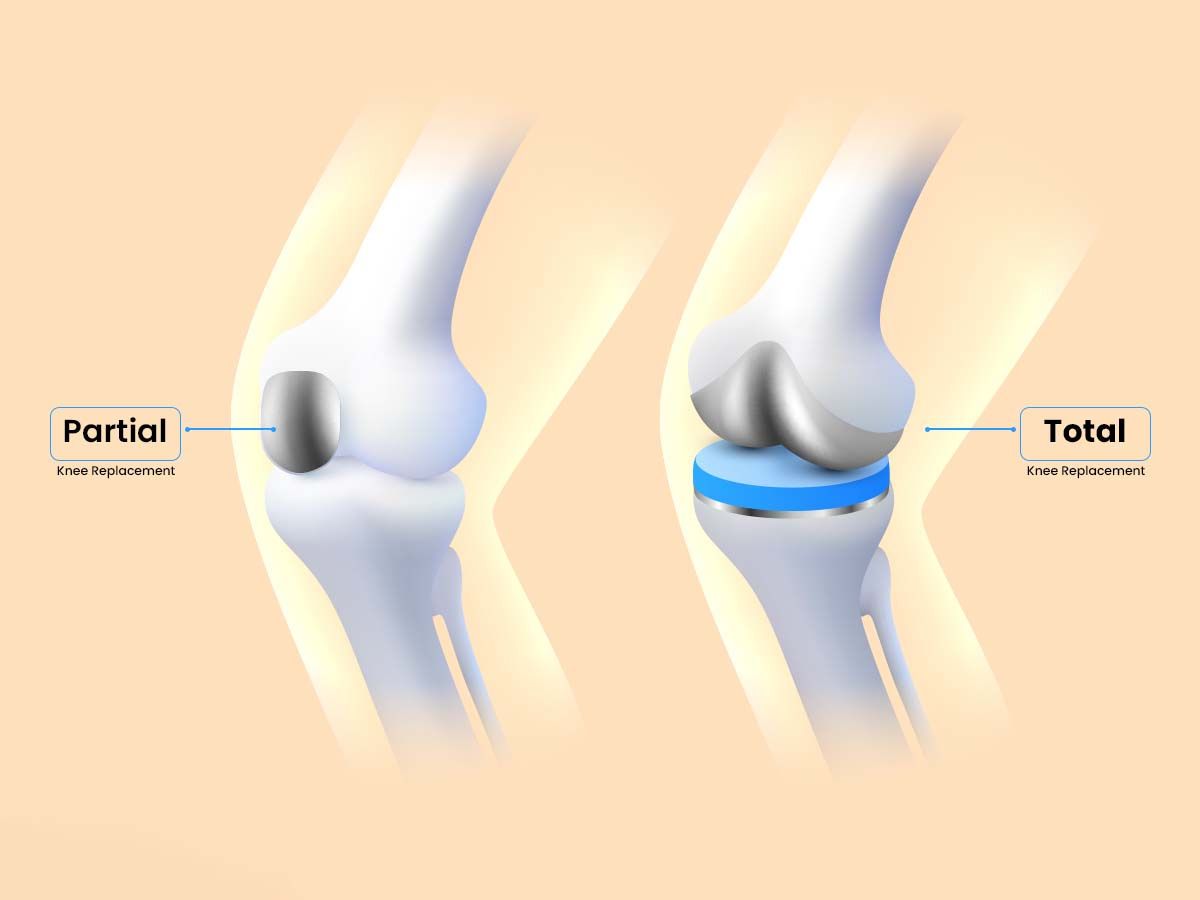
Different knee replacement surgeries: partial, total, and revision
Knee replacement surgery may be a fruitful treatment option if your knee doesn’t respond to other treatments, such as medications and lifestyle changes. Depending on the condition of your affected knee, it is possible to get either a total or a partial knee replacement surgery. You are also allowed to have surgery on both knees at the same time if your condition demands that.
In this article, we will take a closer look at different knee replacement surgeries you can opt for based on your current condition.
Common types of knee replacement surgery
Three of the most common types of knee replacement surgery include total knee replacement, partial (unicompartmental) knee replacement, and revision or complex knee replacement. There’s another type known as kneecap replacement (patellofemoral arthroplasty); however, we will discuss only the first three types of knee replacement in this article.
Total knee replacement surgery
Most of the Total Knee Replacement surgeries involve replacing the joint surface at the end of your thigh bone (femur) and the joint surface at the top of your shin bone (tibia).
A total knee replacement surgery may also involve replacing the undersurface of your kneecap/patella with a smooth plastic dome. Some surgeons prefer preserving the natural patella if possible, but at times the decision needs to be made during the operation.
The new parts are usually cemented in place. If cement is not used, the surface of the component facing the bone is coated or textured to encourage the growth of bone onto it, thereby forming a natural bond.
Another quite common technique is to use a plastic bearing that isn’t fixed firmly to the metal parts. This can assist in reducing wear and tear on your new joint, though it hasn’t been shown to provide better results in the long run.
Partial (unicompartmental) knee replacement surgery
In the event of arthritis affecting only one side of your knee, typically the inner side, it might be possible to carry out a partial or unicompartmental knee replacement surgery. When it comes to having a partial knee replacement in Hyderabad, you should contact the Sunshine Bone & Joint Institute situated in Telangana.
We offer 30 superspecialists under one roof, therefore cross consultations and second opinions will be readily available ensuring every patient receives the best treatment. Moreover, we offer pre and post-operative care that’s provided by qualified orthopaedic surgeons, rather than MBBS doctors, thereby making sure they’re well-trained to diagnose and treat any complications.
Now, coming back to the partial knee replacement surgery, you should know that there are three compartments of your knee. The inner (medial), the outer (lateral), and the kneecap (patellofemoral). In case arthritis affects only one side of your knee, generally the inner side, it can be possible to have a partial knee replacement. Owing to the fact that it involves less interference with the knee than a total knee replacement, it typically means better functioning and quicker recovery.
Partial knee replacements can be carried out through an incision (smaller cut) than a total knee replacement, making use of techniques called minimally invasive surgery or reduced invasive surgery. A smaller incision may also reduce the time taken to recover completely.
A partial knee replacement isn’t going to be suitable for everyone because you are required to have strong, healthy ligaments within your knee. More often than not, this won’t be known until the time of operation.
This procedure can be considered at any age. When it comes to younger people, it offers the opportunity to preserve more bone, which is actually helpful in case you need revision surgery at a later stage in your life. When it comes to older people, a partial knee replacement is a less stressful operation that involves less pain and a lower risk of bleeding. However, the outcome of this surgery largely depends on the type of arthritis you’re diagnosed with rather than your age.
You can also consider the more modern robotic partial knee replacement surgery as it is not only more precise and accurate but also customisable according to your anatomy and comes with a faster recovery time and lesser pain. Even though it’s an expensive treatment and not easily accessible, one can actually allow you to save a lot more money in the longer run, as its success rate is almost 96.5%.
The revision or complex knee replacement surgery
A complex or revision knee replacement surgery might be required if you’re having a second or third joint replacement in the same knee or if your arthritis is extremely severe.
Some people may need a slightly more complex type of knee replacement surgery. The usual reasons for this include major deformity of the knee, major bone loss due to fracture or arthritis, or weakness of the primary knee ligaments.
This type of knee replacement usually has a longer stem which enables the component to be fixed more securely into the cavity of the bone. The components might also interlock in the centre of the knee to form a hinge which seeks to provide greater stability. Moreover, additional pieces of metal and/or plastic can be employed to make up for any badly damaged or removed bone.
This particular type of knee replacement surgery may be needed when you’re having a second or third joint replacement in the same knee and could be better from the very beginning if you suffer from severe arthritis.
What are the reasons for someone not having knee replacement surgery?
Unfortunately, some people might not be able to undergo knee replacement surgery even though their arthritis is extremely bad. This can be owing to any of the following reasons- your thigh muscles (quadriceps) are extremely weak and cannot support your new knee joint, or there are long-lasting or deep open sores/ulcers in the skin below your knee, thereby invariably increasing your risk of infection.
Advantages of knee replacement surgery
Some of the benefits of knee replacement surgery include enhanced mobility, freedom from pain, and an improved quality of life, owing to the fact that everyday activities and exercises become easier.
Disadvantages of knee replacement surgery
Some of the possible disadvantages of knee replacement surgery include numbness, difficulties with certain specific movements, and the replacement joints wearing out over time.
When do you need repeated surgery?
The chances of requiring repeated knee replacement surgery are increased in case you are overweight, you do heavy manual work, or you run or play vigorous sports.
Final Words
Getting knee replacement surgery may help with enhanced mobility, reduced pain, and an overall increased quality of life if you’re living with knee osteoarthritis. You should speak with a trustworthy healthcare professional about your available options. They’ll certainly help you to choose the best type of knee surgery based on your specific needs or even offer alternatives to knee surgery.

